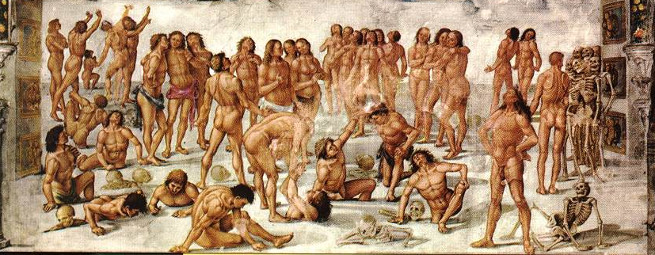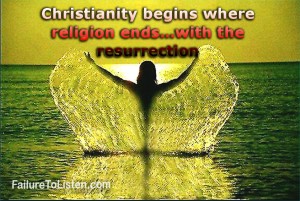[First posted ,2012, reposting every Resurrection Sunday, the Christian “Sabbath” day for the very reason that the Savior supposedly rose from the dead on Sunday. This is one of those posts that simply ask a lot of questions but doesn’t provide an answer . . . to make a point. —Admin1.]
—————————–
There are two verses in the Gospel of Matthew that bible teachers have not satisfactorily explained if even addressed—well, two out of many others, but let’s just deal with this particular text now.
Matthew 27: 52-53
The tombs were opened, and many bodies of the saints who had fallen asleep were raised; and coming out of the tombs after His resurrection they entered the holy city and appeared to many.
If the key to business success is location, location, location, so is the key to ferretting out the meaning of any text: location, location, location . . . or more appropriately. . . context, context, context. Why say it three times?
- Because the first time it refers to the immediate text before and after it;
- the second context is the whole chapter, if not the whole book where the verse occurs;
- and the third context is in the case of bible verses, the whole Bible.
These verses must have been mis-located (misplaced) because they follow verse 50 where Jesus yielded up His spirit and died, then verse 51 where—
“the veil of the temple was torn in two from top to bottom
and the earth shook and the rocks were split.”
(Check out this link questioning this text:
Revisit: The Ark of the Covenant:
Was it in the Holy of Holies on the day Jesus died?)
On careless reading, because of the location of the verses, you might jump to the conclusion that the bodies of “saints” who had “fallen asleep” [euphemism for died] were raised at the moment Jesus died. A more careful reading corrects the actual timing of the misplaced verses which should have been on Resurrection Sunday: “and coming out of the tombs after His resurrection.”
This is not belaboring a minor point, this is what any reader of the bible should be doing, scrutinizing the text, specially if it makes claims that are out of the ordinary. Since the Bible is full of “out of ordinary” phenomena, we should not be surprised about anything it claims; still, within the contexts already explained, it should make sense. And so, since such biblical happenings are not in our experience today, all the more we should endeavor to understand their meaning and their implication in our belief system today.
Upon reading these 2 verses, questions should pop up such as:
- What does the word “saint” mean?
- Who are these “saints”?
- Were there “saints” in those times, as we understand “saints”?
- What are “saints” to Jews?
- What are “saints” to Roman Catholics?
- What are “saints” to Protestant/Evangelicals?
- Are “saints” alive or dead?
- Obviously as the text says, these “saints” were dead; therefore, when they came out of their tombs, what did they look like? Were they skeletal remains, in decomposing stage, recognizable in those conditions . . . or did they appear just like the resurrected Jesus, in ‘new’ resurrection bodies?
- If they were called “saints” then they must have been ‘good’ people when they died, believers in Jesus Christ?
- Did the author of Matthew witness this phenomenon himself or simply heard about it and believed it, enough to record it in his gospel?
- Did the people these saints appeared to not only recognize them but welcomed them back to life?
- Or were the people deathly scared of them, thinking they were ghosts come back to haunt them?
- Did these resurrected “saints” live and die again, just like Lazarus?
- Were people in Jerusalem not excited since, if this was true, so many more dead people, not just Jesus, resurrected from the dead right at that time?
- Did people connect the resurrection of these saints to the resurrection of Jesus, and therefore believe all that Jesus said?
- Or since others resurrected as well, Jesus’ resurrection was no longer a big a deal because he was not alone in rising from the dead?
If anyone reading this knows the answer to any or all the above questions, please post your comment here so Sinaites who are totally clueless can begin to understand verses that have baffled us as former Christians/Messianics.
Add to your explanation as well, the quote on the image: “Christianity begins where religion ends with the resurrection.” Does that really make any sense?
Update 7/19/14
P.S. To provide a balance, here’s the Christian perspective from this website: http://christianity.stackexchange.com/questions/17989/what-is-the-significance-of-dead-saints-being-resurrected-to-life-at-the-crucifixion
Matthew records that immediately after the death of Jesus, many Old Testament saints who had died came back to life, went into Jerusalem, and appeared to many people.
I think it is interesting that this occurred at the death of Jesus and not the resurrection, and I’m not sure what the reason for this could be. My main question though is what the significance was of the Old Testament saints coming back to life physically at this time. This appears to be a sort of “Zeroth” resurrection (borrowing from the Zeroth Law of Thermodynamics, that was asserted after there was already a first and second). | |||||
|
In addition to what’s been said already, this is a preview (mini-version) of Jesus’ second coming, when there will be a great earthquake on the Mt. of Olives (which is a giant cemetery even today) and the all the dead will rise from their graves. | |||||
|




